DRAG DROP -
You are developing a new Power Apps Component Framework (PCF) control.
The control must be deployed to a development environment by using the Power Apps CLI and a new solution.
You need to deploy the PCF control.
Which four actions should you perform in sequence? To answer, move all actions from the list of actions to the answer area and arrange them in the correct order.
Select and Place: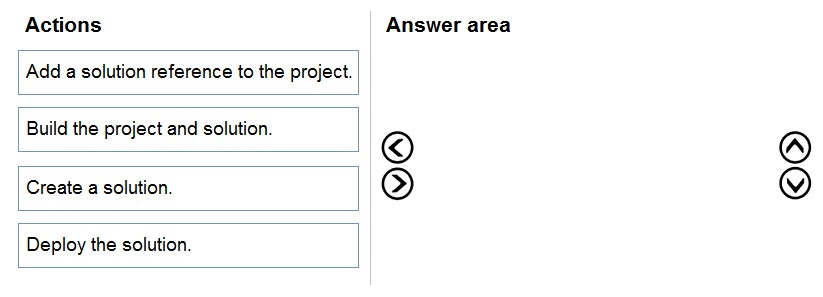
Answer:
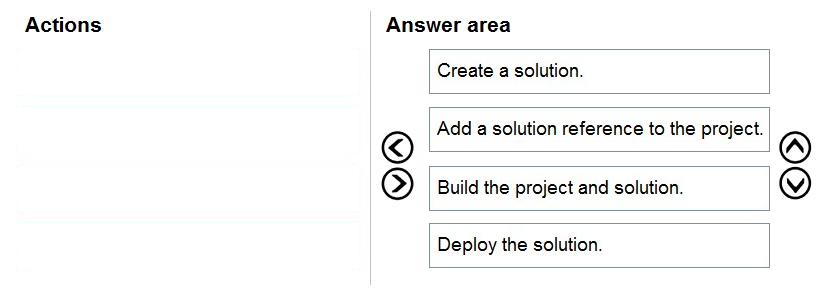
Step 1: Create a solution -
Create a new solutions project using the following command. The solution project is used for bundling the code component into a solution zip file that is used for importing into Dataverse. pac solution init --publisher-name developer --publisher-prefix dev
Step 2: Add a solution reference to the project
Once the new solution project is created, refer the Solutions folder to the location where the created sample component is located. You can add the reference using the command shown below. This reference informs the solution project about which code components should be added during the build. You can add references to multiple components in a single solution project. pac solution add-reference --path c:\downloads\mysamplecomponent
Step 3: Build the project and solution
To generate a zip file from the solution project, go into your solution project directory and build the project using the following command. msbuild /t:build /restore
Step 4: Deploy the solution -
Reference:
https://docs.microsoft.com/en-us/powerapps/developer/component-framework/import-custom-controls
DRAG DROP -
You create solutions in a development environment and export the solution for testing by various departments in your organization. Power users in each department control the testing environments.
You must display department-specific wording at the beginning of any custom notifications that are displayed in testing environments.
You need to package solutions to ensure that the power users can customize the notification content.
Which three actions should you perform in sequence inside a solution? To answer, move the appropriate actions from the list of actions to the answer area and arrange them in the correct order.
Select and Place: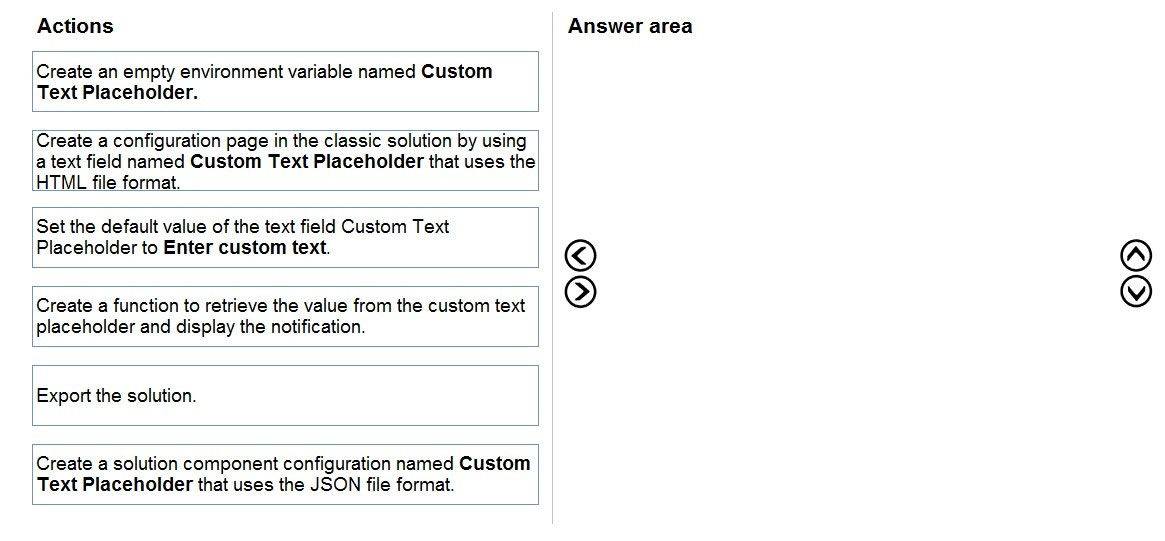
Answer:
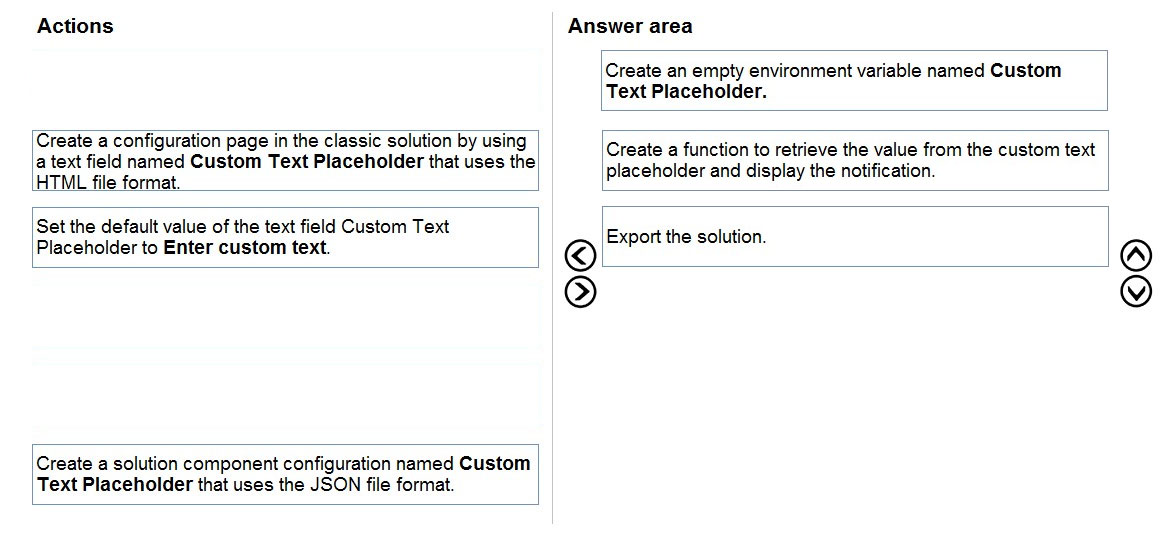
Step 1: Create an empty environment variable named Custom Text Placeholder.
Applications often require different configuration settings or input parameters when deployed to different environments. Environment variables store the parameter keys and values, which then serve as input to various other application objects. Separating the parameters from the consuming objects allows you to change the values within the same environment or when you migrate solutions to other environments.
Step 2: Create a function to retrieve the value from the custom text placeholder and display the notification.
Step 3: Export the solution -
You can manually export solutions. Microsoft recommends that you create an unmanaged solution to use for exporting your customizations, and then export your customizations periodically so that you have a backup in case anything happens.
Reference:
https://docs.microsoft.com/en-us/powerapps/maker/data-platform/environmentvariables https://docs.microsoft.com/en-us/powerapps/maker/data-platform/export-solutions
HOTSPOT -
You need to use the Dynamics 365 Sales Web API to retrieve metadata information.
How should you complete the Web API queries? To answer, select the appropriate options in the answer area.
NOTE: Each correct selection is worth one point.
Hot Area: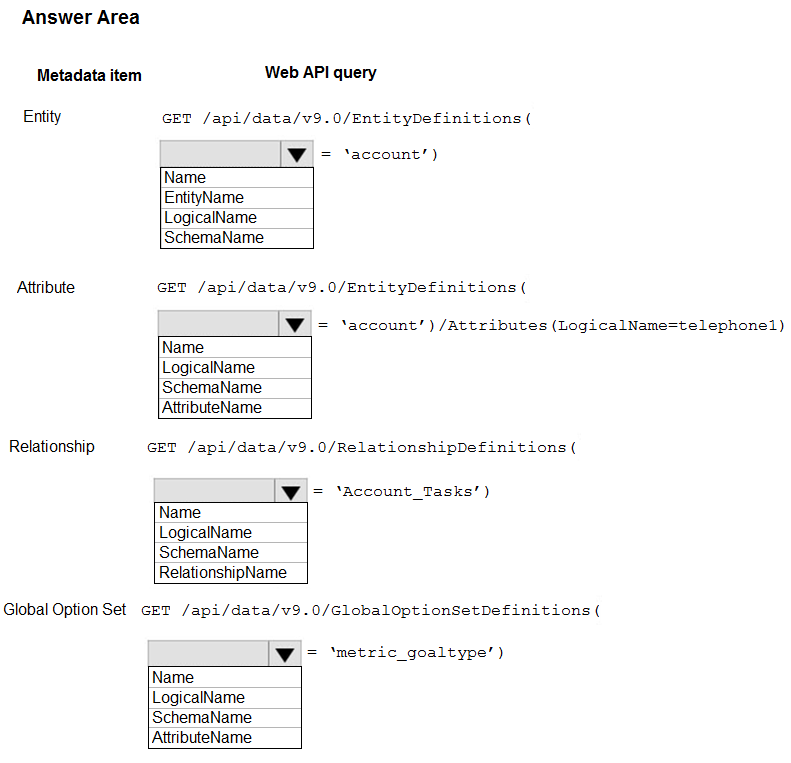
Answer:

Entity: LogicalName -
Querying the EntityMetadata entity type:
GET [Organization URI]/api/data/v9.0/EntityDefinitions(LogicalName='account')
Attribute: LogicalName -
Retrieving attributes:
GET [Organization URI]/api/data/v9.0/EntityDefinitions(LogicalName='account')/Attributes(
Relationship: SchemaName -
Querying relationship metadata:
Entity relationships can also be queried using the RelationshipDefinitions entity set. You can use a query like the following to get the SchemaName property for every relationship.
GET [Organization URI]/api/data/v9.0/RelationshipDefinitions?$select=SchemaName
Global Option Set: Name -
Querying Global OptionSets:
GET /api/data/v9.0/GlobalOptionSetDefinitions(Name='metric_goaltype')
Note: Retrieving items by name is generally easier because you probably already have some reference to the metadata item name in your code. The following table lists the alternate key properties for retrieving metadata items by name.
Reference:
https://docs.microsoft.com/en-us/powerapps/developer/data-platform/webapi/query-metadata-web-api
You are creating a custom connector in Power Apps to connect to a third-party application.
The definition in the connector must be set so that it is not visible to the end user.
You need to select the appropriate visibility parameter.
Which parameter should you use?
Answer:
C
Leave the Visibility property set to none. This property for operations and parameters in a logic app or flow has the following options:
✑ none: displayed normally in the logic app or flow
✑ advanced: hidden under an additional menu
✑ internal: hidden from the user
✑ important: always shown to the user first
Reference:
https://docs.microsoft.com/en-us/connectors/custom-connectors/define-blank
HOTSPOT -
A model-driven app has the following JavaScript code. The code is attached to the OnChange event of the Phone (telephone1) field on the Account entity.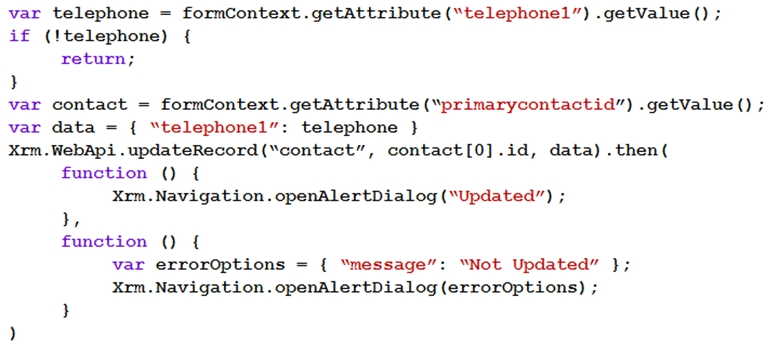
For each of the following statements, select Yes if the statement is true. Otherwise, select No.
NOTE: Each correct selection is worth one point.
Hot Area: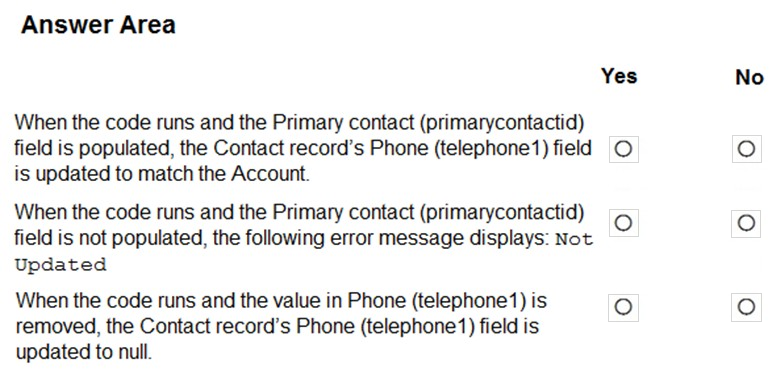
Answer:
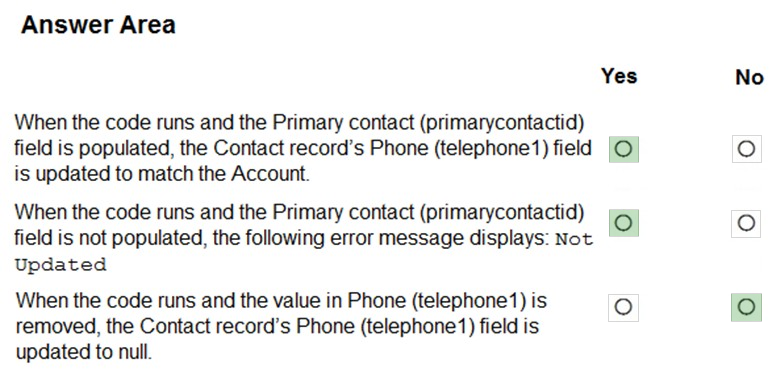
Box 1: Yes -
Xrm.WebApi.updateRecord updates a table record.
Syntax:
Xrm.WebApi.updateRecord(entityLogicalName, id, data).then(successCallback, errorCallback);
Box 2: Yes -
Box 3: No -
No action would be taken.
Reference:
https://docs.microsoft.com/en-us/powerapps/developer/model-driven-apps/clientapi/reference/xrm-webapi/updaterecord
DRAG DROP -
Teachers in a school district use Azure skill bots to teach specific classes. Students sign into an online portal to submit completed homework to their teacher for review. Students use a Power Virtual Agents chatbot to request help from teachers.
You need to incorporate the skill bot for each class into the homework bot.
Which three actions should you perform in sequence? To answer, move the appropriate actions from the list of actions to the answer area and arrange them in the correct order.
Select and Place: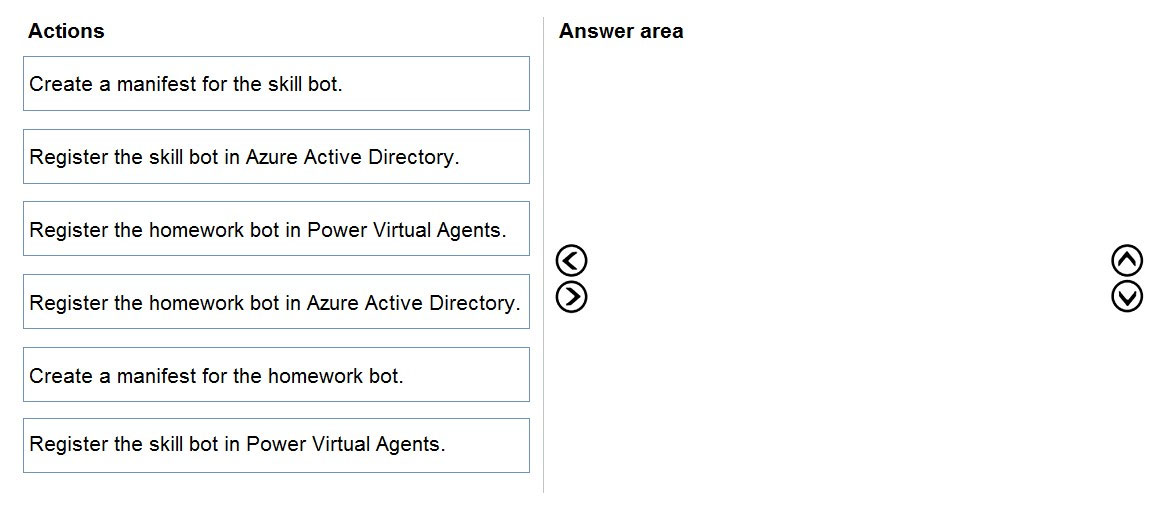
Answer:
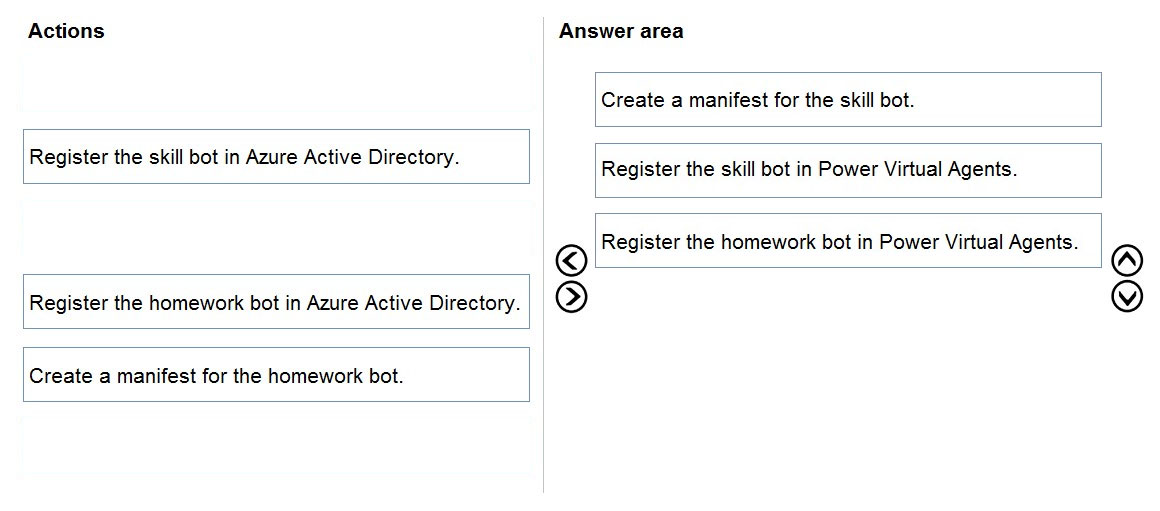
Step 1: Create a manifest for the skill bot
You can use skills to extend another bot. A skill is a bot that can perform a set of tasks for another bot.
A skill's interface is described by a manifest.
Step 2: Register the skill bot in Power Virtual Agents
Power Virtual Agents enables you to extend your bot using Microsoft Bot Framework skills.
First, create a Power Virtual Agents bot and create and deploy the skill using pro-code tools into your organization.
Next, register a skill in Power Virtual Agents.
Step 3: Register the homework bot in Power Virtual Agents
You can use your Power Virtual Agents bot as a skill with Bot Framework bots.
The Bot Framework and Power Virtual Agents bots must be deployed in the same tenant.
Reference:
https://docs.microsoft.com/en-us/azure/bot-service/skill-implement-skill https://docs.microsoft.com/en-us/azure/bot-service/skills-write-manifest
A company is migrating from an on-premises Dynamics 365 installation to a Power Platform solution. You are creating plug-ins for the new solution.
You need to register the plug-ins.
Which isolation mode should you use?
Answer:
C
You will find options related to the isolation mode and location for the assembly. These refer to options that apply to on-premise deployments. Dataverse is not available for on-premises deployments, so you will always accept the default options of SandBox and Database for these options.
Reference:
https://docs.microsoft.com/en-us/powerapps/developer/data-platform/register-plug-in
An organization uses a public-facing Power Apps portal.
You need to change the layout of a specific web page.
What are two possible ways to achieve the goal? Each correct answer presents a complete solution.
NOTE: Each correct selection is worth one point.
Answer:
AD
A: The Portal Management app lets you do advanced configuration actions on your portal.
1. Open the Portal Management app.
2. Go to Portals > Web Pages.
3. To edit an existing web page, select the web page name.
4. Enter appropriate values in the fields.
5. Select Save & Close.
D: To use the WYSIWYG editor:
1. Edit the portal to open it in Power Apps portals Studio.
2. Select the page on which you want to add the component.
3. Select an editable element on the canvas.
Reference:
https://docs.microsoft.com/en-us/powerapps/maker/portals/configure/web-page https://docs.microsoft.com/en-us/powerapps/maker/portals/compose-page
You are building a custom application in Azure to process resumes for the HR department.
The app will monitor submissions of resumes and parse the resumes.
You need to parse the resumes and save contact and skills information into the Common Data Service.
Which mechanism should you use?
Answer:
A
Improve operational efficiency with a unified view of business data by creating flows that use Dataverse (Common Data Service has been renamed to Microsoft
Dataverse as of November 2020).
For example, you can use Dataverse within Power Automate in these key ways:
Create a flow to import data, export data, or take action (such as sending a notification) when data changes.
Instead of creating an approval loop through email, create a flow that stores approval state in an entity, and then build a custom app in which users can approve or reject items.
Reference:
https://docs.microsoft.com/en-us/power-automate/common-data-model-intro
DRAG DROP -
You are researching integrations with several external systems.
Each integration has different requirements.
You need to determine which data sources to use to meet each requirement.
What should you use? To answer, drag the appropriate data sources to the correct requirements. Each data source may be used once, more than one, or not at all. You may need to drag the split bar between panes or scroll to view content.
NOTE: Each correct selection is worth one point.
Select and Place:
Answer:

Box 1: Virtual entity -
Initially, defining a virtual entity is the same as defining a custom entity: you specify the entity, attributes, and relationships for the new virtual entity type.
You can use GUIDs as primary keys in the external data source.
Box 2: Virtual entity -
Virtual entities enable the integration of data residing in external systems by seamlessly representing that data as entities in Microsoft Dataverse (Common Data
Service), without replication of data and often without custom coding. Virtual entities support create, updates and delete of data in the external system.
Box 3: Custom connector -
A custom connector is a wrapper around a REST API (Logic Apps also supports SOAP APIs) that allows Logic Apps, Power Automate, or Power Apps to communicate with that REST or SOAP API.
Reference:
https://docs.microsoft.com/en-us/powerapps/developer/common-data-service/virtual-entities/get-started-ve